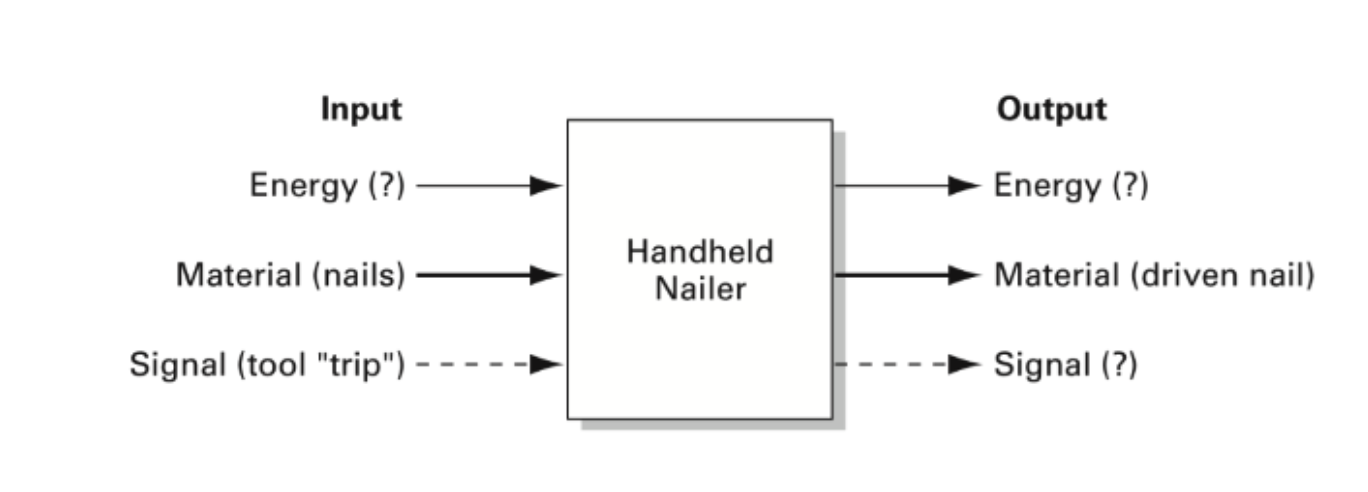Concept Generation and Selection
The Four Steps to Concept Generation
Concept generation is an important step in the product development process that can itself be broken down into steps. Going into these steps, you will usually need the customer needs list, preliminary product specification and a mission statement for the project which you created in the previous exercises.
The steps to the process are:
- Clarify the problem
- Search externally
- Search internally
- Explore systematically
STEP 1: Clarify the Problem
To clarify the problem, breaking the product into smaller subproblems is helpful. This can be done using a functional diagram.
A functional diagram is something that first breaks down all the inputs and outputs of a product and then walks through how the inputs become the outputs. An example is shown below for a handheld nailer.
With arrows, the (1) energy, (2) material, and (3) control or signals are indicated. In the case of the screw driver shown here: (1) energy: taken from the electrical outlet and stored in the battery, this energy can then be converted into translational energy that drives the nail, (2) material: in this case the nails, are loaded into the device, isolated before use, and then once energy is applied, the nail is ejected, (3) control or signals: the user trigger the nailer with a button therefore "tripping" the sensor, this triggers the tool which first isolates the nail and then allows energy to be applied to drive the nail.

Ulrich, K. T., & Eppinger, S. D. (2016). Product design and development.
STEP 2: External Search
External searching is an important step of the product development process. Performing a thorough external search means that you have found the all the major existing solutions for the problem or subproblems that the functional diagram revealed. There are a few different ways to do this, including lead user interviews, expert consultation, patent searching, literature searching, and competitive benchmarking.
Interview lead users: These are people who stand to gain the most from the new product. Usually, these are people who have already taken some steps to address this need, or at least have thought about how it might be addressed. Within assistive technology fields, lead users can many times be thought of as co-designers who are very involved in the design, build, and testing of the product.
Consult experts: These are professionals who deal with this product or related field within their work, such as university faculty, suppliers, manufacturers of similar products, or medical professionals (especially in the case of assistive technology). These people can lend technical and industry insight, and they can often connect you with those who can. Asking for contacts is important when consulting experts.
Search patents: There are two major functions of patent searching: (1) finding out what has been done and, (2) finding out what is covered by patent and intellectual property laws. Concepts in recent patents are usually protected, meaning you must pay the patent holder to use that technology, but patent laws vary from country to country. We will not be covering patent searches in this course, though if you are designing and marketing your own products, you need to be aware of what the relevant patent laws are like in your country!
Search published literature: This is an often overlooked step in the design process that can lead to doubling work that someone else has already thought about and sometimes implemented! Literature includes journals, trade magazines, government reports, conference proceedings, public information from manufacturers, etc. This search is usually done via internet databases.
Benchmarking related products: Finding and studying existing products that do the same or very similar functions is called benchmarking. If planning to commercialize your product this is like scoping out the competition and the pros and cons of their solution.
STEP 3: Internal Search
This is what most people think of as brainstorming and there are several ways to go about doing this, both in groups and individually. Here are a few tips for successful concept generation internally:
- Generate many ideas: The more ideas that are brought into consideration, the more of the full solution space is explored meaning the less likely the team has left out a good solution. This includes suspending judgment of the ideas and accepting seemingly infeasible ideas at first.
- Draw things out and/or build a model: Making a physical representation of an idea has been shown to lead to better design outcomes. It allows the designers to interact with the idea in a way that gives more information.
- Make analogies (Design by analogy): Think of devices or products (or solutions) that solve a related problem for insight into your own problem. This includes looking to biological analogies, often called bio-inspired design. This concept has become very popular in engineering and science within the last decades. For some examples see this popular science article from 2011.
- Set quantitative goals and share individual work: It can be helpful for each team member to generate a certain minimum number of concepts and then share with the group to spark further ideas within the group. This can effectively be done with the "gallery method" where each individual can tape a sketched concept to the board and explain that idea.
STEP 4: Explore Systematically
Once the problem has been clarified, researched externally, internally brainstormed, and many solutions to the subproblems have been found, it is time to explore these in a structured way. There are several ways to go about doing this. One of these ways is by making a pros and cons list for each viable solution.